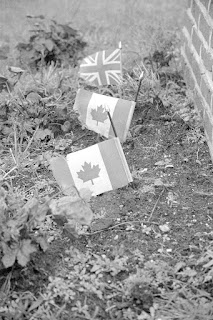At 23:53 on the 30th of April, 1943 No 77 Squadron Halifax B.II JB803/KN-G piloted by Sergeant Gordon Watson took off from RAF Elvington. Its target that night was Essen, a German city in the Ruhr industrial area. The Battle of the Ruhr was in full swing.
The aircraft
The Handley Page Halifax was a four engined heavy bomber in use with the RAF from 1940 until 1952 and was broadly comparable to the more famous Lancaster bomber. The Halifax B Mark II was powered by the legendary Merlin engine of Spitfire and Hurricane fame. 1,966 Halifax B.II's were built, not only by Handley Page but also by other manufacturers. Later versions of the Halifax used the Bristol Hercules engine that proved to be a better match to the Halifax airframe than the Merlin.
JB803 was an English Electric built Halifax B Mark II and was delivered from their Preston factory to the RAF somewhere between the 21st of February 1943 and the 1st of March 1943. After acceptance it was used almost immediately. Known missions of JB803 are:
11/03/1943 Stuttgart raid
21/03/1943 Essen raid
29/03/1943 Berlin raid
02/04/1943 Lorient raid
03/04/1943 Essen raid
04/04/1943 target unknown
08/04/1943 Duisburg raid
10/04/1943 Frankfurt raid
14/04/1943 Stuttgart raid
16/04/1943 Pilsen raid
20/04/1943 Stettin raid
26/04/1943 Duisburg raid
27/04/1943 Mine laying
28/04/1943 Mine laying
30/04/1943 Essen raid
The crew
JB803 carried a mixed Royal Air Force/Royal Canadian Air Force crew of seven that night:
Pilot Sergeant Gordon Watson, RAF Volunteer Reserve service number 1383608
Flight Engineer Sergeant Ian Douglas Crawford, RAF service number 634710
Navigator Flying Officer Arthur Edward Parsons, RCAF service number J/11636
Bomb Aimer Sergeant Leon Hannam, RAF Volunteer Reserve service number 1383305
Wireless operator/Air Gunner Sergeant William Robert Louth, RAF Volunteer Reserve service number 1198324
Mid Upper Gunner Sergeant Raymond Shepherd, RAF Volunteer Reserve service number 929961
Tail Gunner Flight Sergeant Thomas Deuel Scarff, RCAF service number R/95040
The mission
Watsons crew was going back to the Krupp factory in Essen. After takeoff from RAF Elvington at 23:53 Watson steered JB803 towards Cottesmore Light and proceeded afterwards to North Walsham, Happisburgh and Egmond before heading to Essen. After reaching their target they would return via Egmond and Hornsea and land back at Elvington. It was their 13th mission as a crew (with the exception of Louth who was on his sixth flight with Watsons crew and Shepherd who was on his fourth). Their Halifax was loaded with two 1,000 lb general purpose bombs and thirteen incendiary bombs of two types.
After crossing the Dutch coast line they were intercepted by a Messerschmitt Bf-110 night fighter from 11./NJG 1 flown by Feldwebel Heinz Vinke, Feldwebel Karl Schödel and Unteroffizier Johann Gaa. Vinke and his crew were based at Bergen airfield on the Dutch coast that night. Vinke located the Halifax and shot it down. Vinke was a night fighter ace, racking up 54 kills before he and his crew themselves got shot down and killed whilst flying Bf-110G-4 werknummer 740136 by Flight Officer Hardy in a Hawker Typhoon on February 26th, 1944.
Watson ordered his crew to bail out and all but Scarff and Watson himself did so. They died when their bomber crashed and exploded at the Noordpolder near Muiden, the Netherlands at 02:26 on May 1st, 1943. The rest of his crew landed in the cold water of the IJsselmeer lake and never made it to shore.
Watsons crew lies buried at the Muiden General Cemetery with the exception of Sergeant Louth. His body was never recovered.
The memorial
The current memorial for the crew of Halifax B.II JB803 was erected at the Zuidpolderweg at the site where the Halifax crashed in 1943. It was unveiled on September 5th, 2020. Each year at May 1st the local community gathers at the memorial to remember Watson and his crew.





Impressive story with appropriately moody photographs. This strange time really comes to life for me the way you tell it.
ReplyDeleteThanks Joeri!
Delete